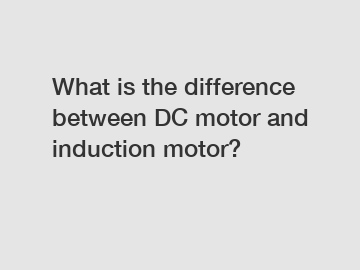What is the difference between DC motor and induction motor?
When it comes to motors, there are many different types available on the market. Two popular options are the DC motor and the induction motor. While both serve the same basic purpose of converting electrical energy into mechanical energy, there are some key differences between the two that are important to understand. In this article, we will explore the main distinctions between DC motors and induction motors to help you make an informed decision on which one is best suited for your needs.
One of the primary differences between DC motors and induction motors lies in how they are powered. DC motors run on direct current, which means that the electrical current flows in only one direction. This makes them simple and straightforward to control, as the speed of the motor can easily be adjusted by changing the voltage or current supplied to it. This makes DC motors ideal for applications where precise speed control is required, such as in robotics or industrial automation.
In contrast, induction motors run on alternating current, meaning that the electrical current changes direction periodically. This creates a rotating magnetic field within the motor that drives the rotation of the rotor. While this design may seem more complex compared to DC motors, induction motors have the advantage of being more efficient and reliable over the long term. They also have the ability to self-start, making them a popular choice for a wide range of applications, from household appliances to industrial machinery.

Another key difference between DC motors and induction motors is their construction. DC motors typically have a split-ring commutator and carbon brushes, which help to switch the direction of the current in the motor and transfer power to the rotor. While this design works well for smaller motors, it can be prone to wear and tear over time, leading to maintenance issues and reduced lifespan.
Induction motors, on the other hand, have a simpler and more robust design, with no brushes or commutator. This means that there are fewer moving parts to wear out, resulting in a motor that is more reliable and requires less maintenance. Induction motors are also known for their high efficiency, with some models capable of operating at up to 95% efficiency. This makes them a popular choice for applications where energy conservation is a priority.
Suggested reading:Are slip rings essential for synchronous motors?
Synchronous Motor: The Game-Changer in Energy Efficiency?
Why Hysteresis Motor is Ideal for Sound Recording Instruments
Exploring Materials Used in Induction Motor Frames
Ultimate Guide: Motor Vibration Causes & Fixes
- "Why Choose Zcl Motor for Superior Performance
On what principle does a synchronous motor work?
In terms of speed control, both DC motors and induction motors have their advantages. DC motors are known for their precise speed control capabilities, allowing them to maintain a constant speed even under varying load conditions. This makes them ideal for applications where speed accuracy is essential, such as in printing presses or conveyor systems.
Induction motors, on the other hand, are typically designed to run at a fixed speed based on the frequency of the electrical supply. However, they can still be controlled by varying the frequency of the supply voltage, using a device known as a variable frequency drive (VFD). This allows induction motors to operate at different speeds, making them suitable for applications where speed flexibility is important, such as in HVAC systems or pumping systems.
In terms of cost, both DC motors and induction motors have a similar upfront price. However, when considering the total cost of ownership, induction motors may be the more cost-effective option in the long run. Their lower maintenance requirements and higher energy efficiency can result in lower operating costs over time, making them a more attractive investment for many applications.
In conclusion, while both DC motors and induction motors have their own unique advantages and drawbacks, the choice between the two ultimately depends on the specific requirements of your application. For applications where precise speed control and compact size are important, a DC motor may be the best choice. However, for applications where energy efficiency, reliability, and low maintenance are the top priorities, an induction motor may be the better option. By understanding the differences between these two types of motors, you can make an informed decision that will help you achieve optimal performance and productivity in your projects.
Are you interested in learning more about Working of Pmsm Motor, Types of Three-Phase Induction Motor, Ac Motors Manufacturer? Contact us today to secure an expert consultation!
Suggested reading:Exploring the Benefits of Cage Rotor Induction
Top 5 Benefits of Slip Ring Induction Motor
The Benefits of Using Slip Ring Induction Motor Applications: A Comprehensive Guide
Synchronous Motor Means vs. Alternating Current Power: A Comparison
How to Choose Advantage and Disadvantage of Synchronous Motor: A Comprehensive Guide

